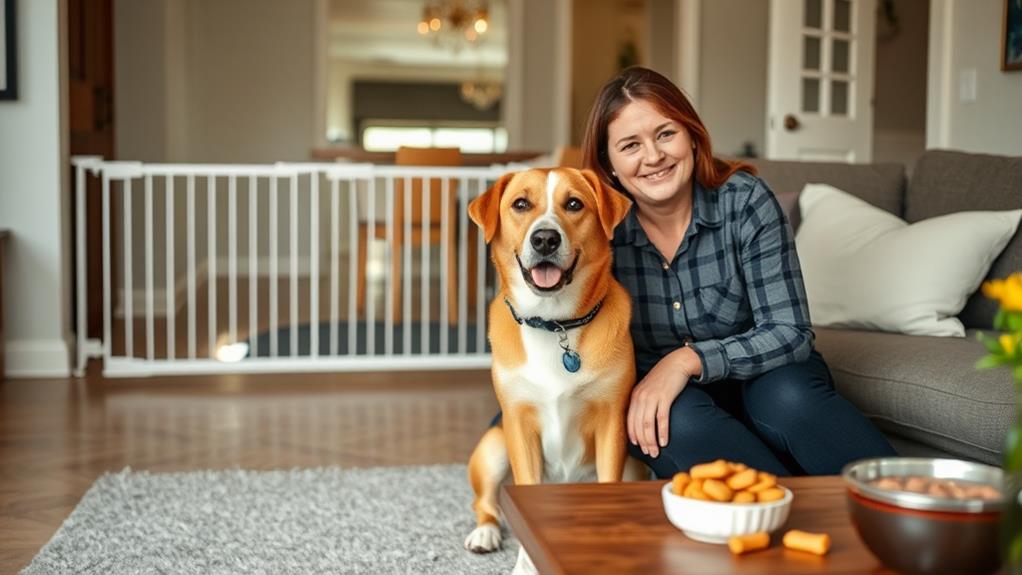To stop your dog from jumping up, follow these seven steps. First, understand why they jump—usually for attention or excitement. Teach them an alternative command, like "sit," and use positive reinforcement when they stay grounded. Manage excitement by creating calm environments before triggers happen. Practice consistent responses; everyone in your household should use the same commands and ignore jumping. Redirect their energy with toys instead of allowing jumping, and socialize them with other dogs to learn proper behavior. These steps are simple but effective, and you'll find more helpful details ahead to make the process smoother.
Understand the Behavior
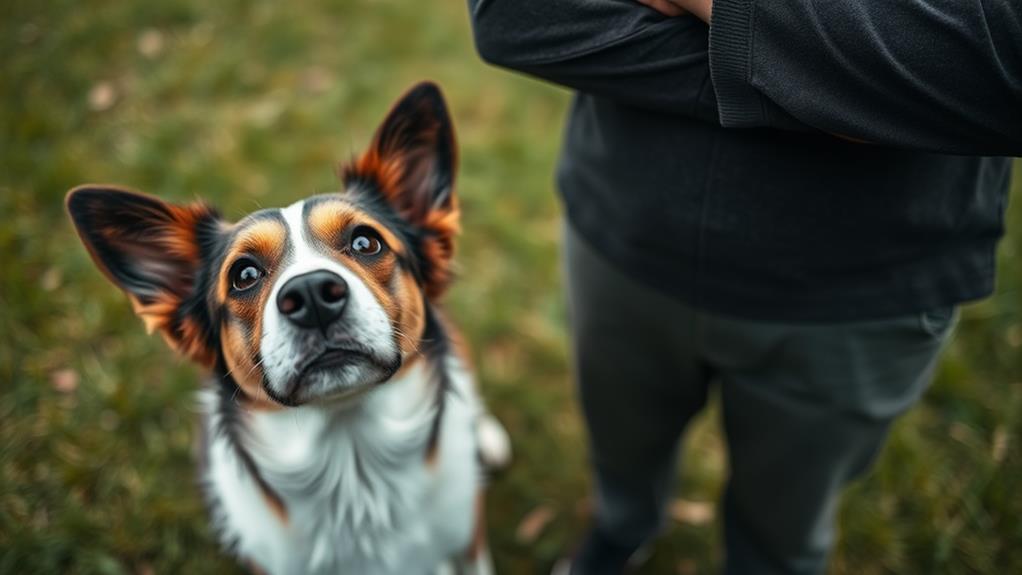
When you understand why your dog jumps up, you can better address the behavior. Dogs often jump as a way to greet you, express excitement, or seek attention. It's their natural instinct to show affection or engage with you. When you walk through the door, your dog's immediate reaction might be to jump, believing this is how they can get your attention.
Your dog may also be responding to their environment or the people around them. If they see someone new or an excited friend, jumping becomes their way of joining the fun. They don't realize that this behavior can be perceived as rude or overwhelming.
Additionally, some dogs jump because they've learned that it works. If you've inadvertently rewarded them with attention or petting when they jump, they'll associate this action with positive outcomes.
Understanding the underlying reasons for your dog's jumping can help you formulate a plan to manage it effectively. It's indispensable to observe your dog's triggers and emotional state during these moments. By recognizing these patterns, you can create a more controlled and enjoyable interaction between you and your furry friend.
Teach an Alternative Command
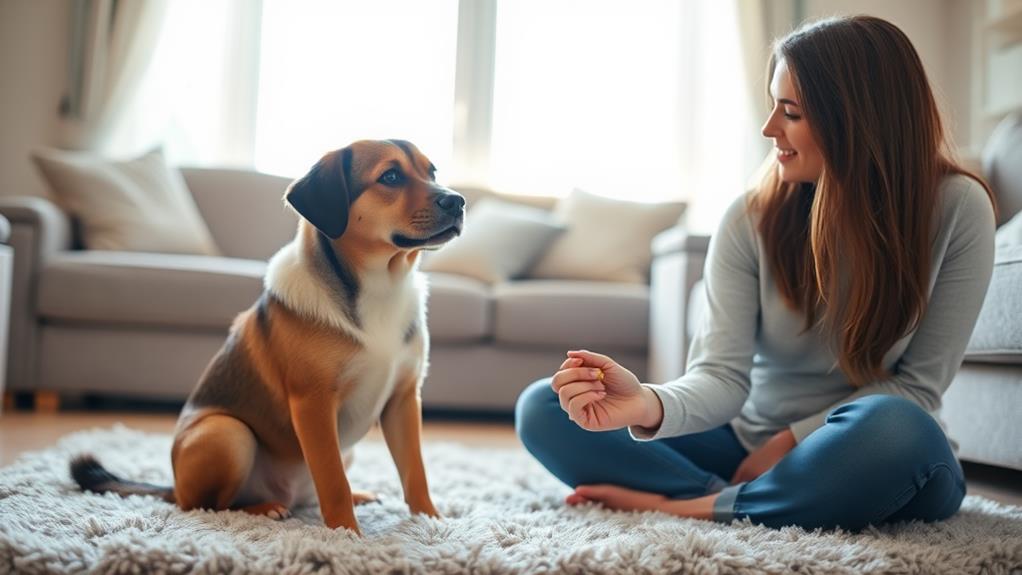
To address your dog's jumping behavior, teaching an alternative command can be highly effective. Start by choosing a command that suits the situation, like "sit" or "down." This will give your dog a clear behavior to focus on instead of jumping.
Begin training in a quiet environment with minimal distractions. Use a leash if necessary to keep your dog close. When someone approaches, calmly say your chosen command. If your dog starts to jump, gently pull them back while repeating the command. Consistency is key, so practice this regularly.
Once your dog understands the command, try it with friends or family. Ask them to approach as you give the command, ensuring your dog remains in a sitting or lying position. Reward your dog with praise or a treat when they comply. This reinforces that staying down is a good choice.
Use Positive Reinforcement
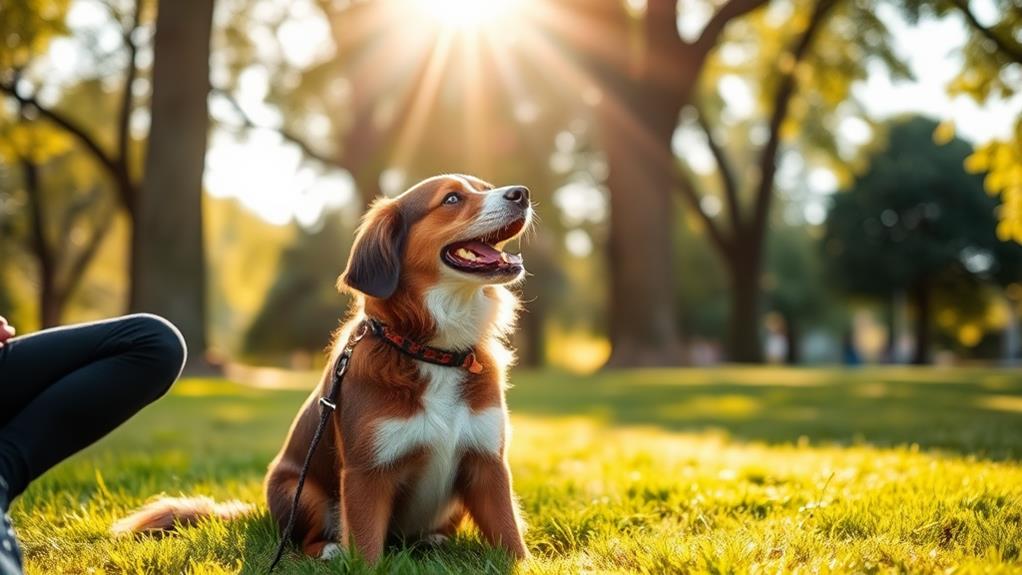
Using positive reinforcement is an effective way to discourage your dog from jumping up, as it encourages desired behaviors through rewards. When your dog stays on the ground instead of jumping, immediately reward them with treats, praise, or affection. Consistency is key; always reinforce the behavior you want to see.
Here's a simple table to help you visualize some effective strategies:
| Behavior to Reinforce | Type of Reward |
|---|---|
| Dog sits calmly | Treat or praise |
| Dog remains on leash | Affection |
| Dog approaches gently | Playtime |
| Dog lies down | Favorite toy |
Manage Excitement Levels
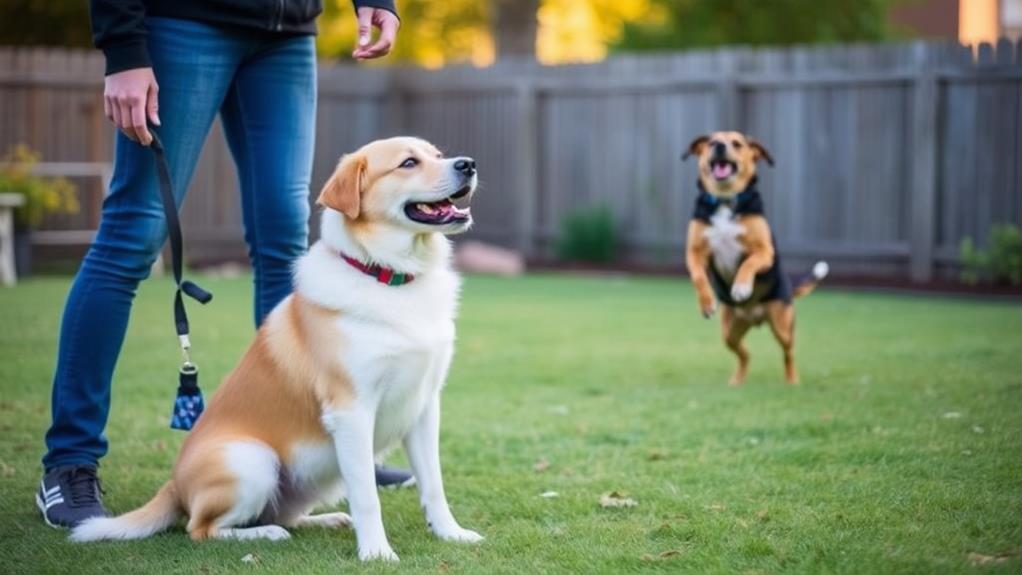
Dogs often get overly excited, which can lead to jumping up on people. To manage this excitement, start by recognizing the situations that trigger your dog's enthusiasm. Is it when friends arrive, or during playtime? Identifying these moments allows you to prepare in advance.
Next, create a calm environment before these triggers occur. For example, when guests come over, have your dog on a leash or in another room until everyone settles down. This prevents them from getting too hyped up upon arrival. You can also practice controlled greetings by asking your guests to ignore the dog until they're calm.
Engage in regular exercise to help burn off excess energy. A well-exercised dog is often a calmer dog. Incorporate walks, fetch, or other activities into your routine to keep your pup physically and mentally stimulated.
Try using calming techniques like deep breathing or soothing music to help your dog relax. When you notice their excitement levels rising, redirect their focus to a toy or a command to help them settle down. By managing their excitement, you'll create a more pleasant environment for everyone involved.
Practice Consistent Responses
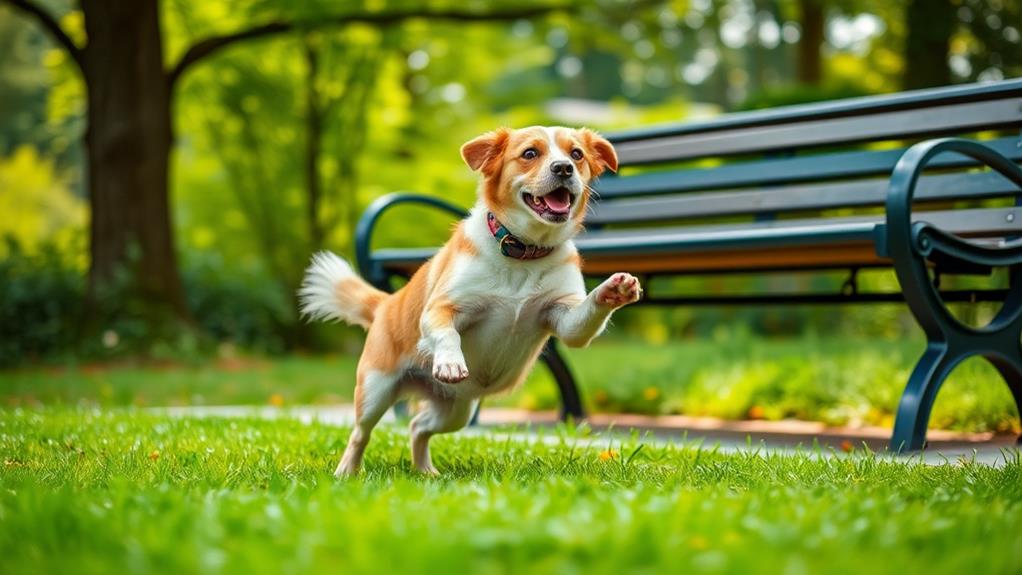
Consistency is key when it comes to stopping your dog from jumping up. If you want to see real progress, you'll need to respond the same way every time your dog jumps. This helps your pup understand what's expected and reduces confusion.
Here are four ways to guarantee consistent responses:
- Establish a Command: Choose a specific command like "off" or "down" that you'll use each time your dog jumps. Make sure everyone in your household uses the same command to avoid mixed signals.
- Ignore the Behavior: When your dog jumps, turn your back and avoid eye contact. This shows your dog that jumping won't get them the attention they crave.
- Reward Calm Behavior: When your dog stays on the ground, immediately reward them with treats or praise. This reinforces the behavior you want to see.
- Be Patient: It might take time for your dog to learn. Stay patient and consistent in your responses, even if it feels repetitive.
Redirect With Toys
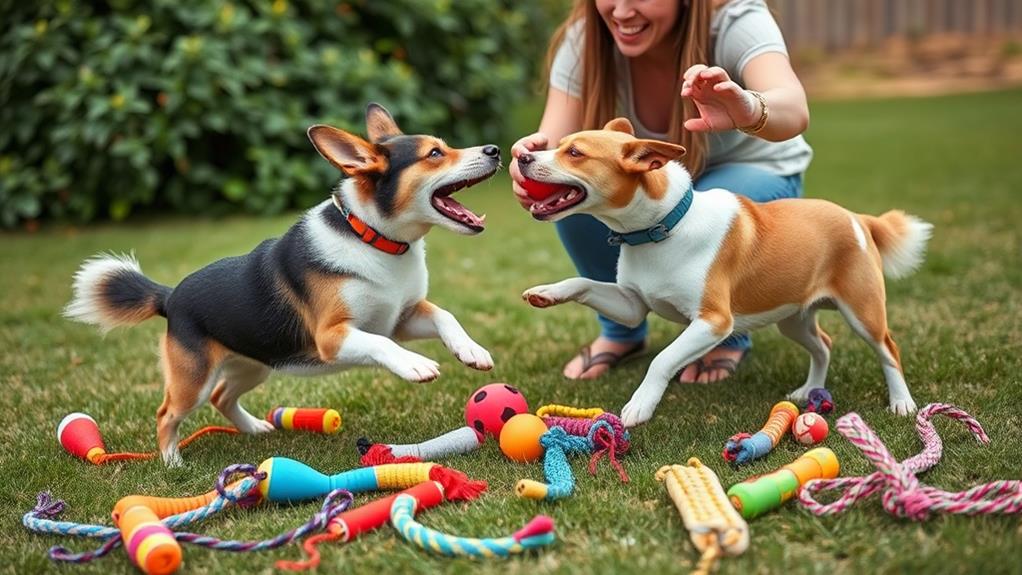
Redirecting your dog's energy can be an effective way to curb jumping behavior. One great method is to use toys to capture their attention and focus. When you see your pup getting ready to jump, grab a toy and engage them in play. This not only diverts their energy but also reinforces positive behavior.
Here's a quick table to help you choose the right toy for your dog:
| Toy Type | Best For | Example Activity |
|---|---|---|
| Chew Toys | Dogs that love to chew | Hide and seek with treats |
| Fetch Toys | Active, high-energy dogs | Classic game of fetch |
| Tug Toys | Dogs that enjoy tugging | Tug-of-war games |
| Interactive Toys | Dogs that need mental stimulation | Puzzle solving with treats |
When your dog begins to jump, redirect them immediately with a toy and encourage them to play instead. Over time, they'll learn that jumping isn't the best way to get your attention. With consistent practice, you'll notice a significant reduction in jumping behavior, making interactions more enjoyable for both of you.
Socialize With Other Dogs
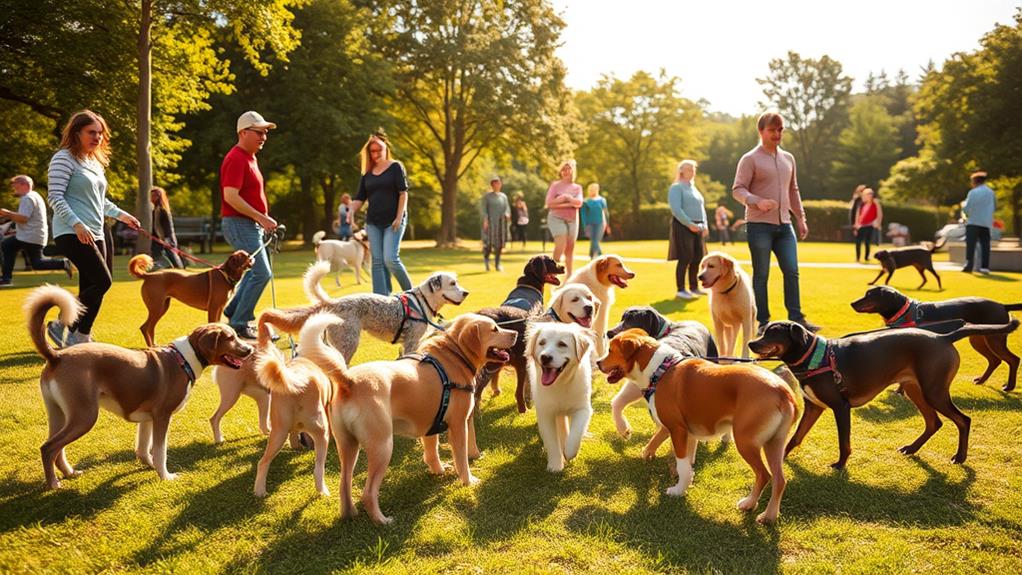
Socializing with other dogs is a crucial step in teaching your pup appropriate behavior, including how to manage their jumping. When your dog interacts with other dogs, they learn important social cues, which can help them understand when it's appropriate to jump and when it's not.
Four effective ways to boost your dog's social skills:
- Join a Dog Park: Take your dog to a local dog park where they can freely interact with other pups. Supervise their play to confirm positive experiences.
- Attend Training Classes: Enroll in obedience or puppy classes. These environments allow your dog to learn alongside other dogs while practicing commands.
- Organize Playdates: Set up playdates with friends or neighbors who've friendly dogs. It's a great way for your pup to bond and practice good behavior in a controlled setting.
- Participate in Group Walks: Join a group of dog owners for walks. This exposes your dog to different dogs and people, reinforcing calm behavior while out and about.
Frequently Asked Questions
What Age Should I Start Training My Dog Not to Jump?
You can start training your dog not to jump as early as eight weeks old. The sooner you begin, the better they'll learn appropriate behaviors, making it easier for you to manage their excitement.
Can Certain Breeds Be More Prone to Jumping?
Certain breeds, like Labradors and Boxers, tend to jump more due to their energetic nature. You'll find that understanding your dog's breed traits can help you manage and reduce this behavior effectively.
How Long Will It Take to See Results?
You'll likely see results within a few weeks, but it depends on consistency and your dog's temperament. Stay patient and keep practicing; with time, your efforts will pay off, and your dog will learn.
Is It Safe to Allow Some Jumping in Specific Situations?
Allowing some jumping can be safe in specific situations, like playtime or greeting familiar people. Just guarantee it's controlled and doesn't reinforce unwanted behavior, keeping your dog's overall training in mind for consistency.
Should I Punish My Dog for Jumping?
Imagine your dog leaping like a furry kangaroo! Instead of punishment, focus on redirection. You'll teach them proper behavior through positive reinforcement. Remember, jumping's just their way of saying, "Hey, look at me!"
Conclusion
By following these seven steps, you can turn your pup's jumping habit into calm greetings. Remember, patience is key—just like learning to ride a bike, it takes practice! With consistency and love, you'll transform those enthusiastic leaps into gentle hellos. So, don't just dream of a well-mannered dog; take action today and watch your furry friend flourish! After all, a little effort now leads to a lifetime of joy and connection.

